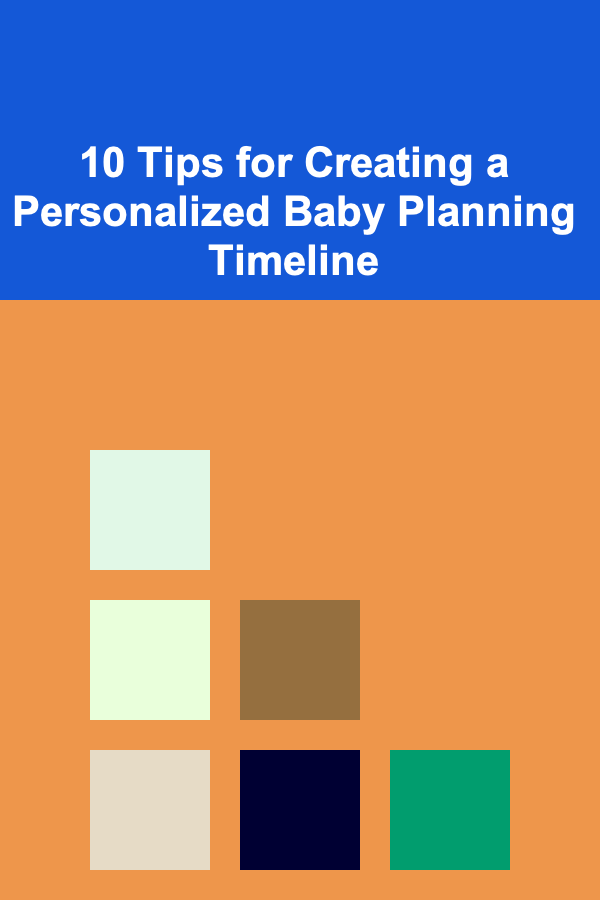
10 Tips for Creating a Personalized Baby Planning Timeline
ebook include PDF & Audio bundle (Micro Guide)
$12.99$9.99
Limited Time Offer! Order within the next:

Becoming a parent is one of life's most profound experiences, filled with joy, anticipation, and sometimes overwhelming uncertainty. One of the best ways to navigate the journey of pregnancy, childbirth, and the early days of parenthood is by creating a personalized baby planning timeline. A thoughtful timeline not only helps to stay organized but also ensures that no important tasks or milestones are missed, allowing the parents to focus on the emotional aspects of welcoming a new child.
Creating a personalized timeline tailored to your unique needs and circumstances is essential. In this article, we will explore 10 tips to help you build a structured, yet flexible baby planning timeline that will guide you through pregnancy, childbirth, and the first few months of your baby's life.
Start Early: The First Trimester
The journey of pregnancy begins long before your baby arrives. The first trimester is the perfect time to start creating your personalized timeline. During these early weeks, you are likely adjusting to pregnancy itself, but it's crucial to begin planning.
Key Considerations for the First Trimester:
- Consult with your healthcare provider: Schedule your first prenatal visit. During this time, your doctor will provide important information about your pregnancy and the necessary screenings.
- Begin dietary changes: Start implementing a nutritious, pregnancy-friendly diet. Certain foods and vitamins, like folic acid, are crucial during this stage.
- Start thinking about your birth plan: Although it may seem early, having a rough idea of your preferences for labor and delivery will help you make decisions later on.
- Choose your maternity care provider: Whether you're seeing an OB-GYN, midwife, or family doctor, now is the time to decide who will care for you during the pregnancy and delivery.
By laying the foundation for your baby planning during the first trimester, you create a solid base for what's to come.
Organize Your Finances and Insurance
Baby planning isn't just about diapers and cribs; it also involves serious financial planning. The cost of raising a child can be significant, and it's crucial to organize your finances early on.
Steps to Take:
- Review your health insurance: Make sure your insurance covers maternity care, delivery, and newborn services. Understand what's covered and what's out-of-pocket.
- Create a budget: Consider the costs of prenatal care, labor and delivery, baby gear, and other expenses. Factor in your post-birth leave from work as well.
- Start saving for baby-related costs: Open a savings account specifically for baby expenses. This can cover everything from hospital bills to the costs of baby products.
Starting your financial planning early ensures you're prepared for the many costs of becoming a parent.
Build Your Baby Registry
Around the beginning of the second trimester is a great time to start building your baby registry. You'll have more energy, and you may begin to feel more excited about the baby. A well-thought-out baby registry is one of the easiest ways to ensure you get the items you truly need.
Tips for Creating a Baby Registry:
- Research baby products: You don't need everything on the market, so focus on essentials. Prioritize items like a crib, stroller, car seat, and clothing.
- Consider your lifestyle: If you plan to breastfeed, include nursing pads and pumps on your registry. If you're a working parent, you might need daycare items or bottles.
- Think long-term: Some products, like clothes and toys, may be outgrown quickly. Look for items that can grow with your child.
Remember, a baby registry not only helps you get prepared, but it also lets friends and family support you in a practical way.
Design Your Nursery and Baby-Proof Your Home
Preparing your home for the arrival of your baby is one of the most exciting parts of baby planning. However, creating a safe, comfortable space for your newborn requires thoughtful planning.
Steps for Nursery Planning:
- Choose a theme or color scheme: Pick a design that suits both you and the baby. Neutral tones or pastel colors are often a popular choice.
- Invest in furniture: Buy essential furniture like a crib, changing table, and storage units. Make sure they meet current safety standards.
- Baby-proof your home: This goes beyond the nursery. Secure heavy furniture, cover electrical outlets, and install safety gates where necessary.
Having your baby's space ready well in advance ensures that you don't feel rushed as your due date approaches. A peaceful, organized environment will make those first days with your newborn much easier.
Prepare for Maternity Leave
As your due date nears, it's important to begin preparing for maternity leave. Whether you're working a full-time job, freelancing, or running your own business, taking time off is crucial for recovery and bonding with your newborn.
Key Steps for Maternity Leave:
- Know your rights: Understand your employer's maternity leave policies, and if needed, apply for leave early.
- Plan for your absence: If you're working, ensure that your job responsibilities are covered. This may mean training a colleague or organizing your workload in advance.
- Set up financial backup: Ensure you have a financial cushion if your maternity leave is unpaid or partially paid.
Planning ahead for maternity leave ensures a smoother transition when the time comes, allowing you to focus on your baby without financial or professional stress.
Create a Birth Plan
A birth plan is a way for parents to communicate their preferences for labor and delivery to their healthcare provider. While no plan can predict how labor will go, having a plan in place helps reduce anxiety and ensures that everyone is on the same page.
Birth Plan Considerations:
- Location: Do you want to give birth at a hospital, birth center, or at home? Discuss your options with your healthcare provider.
- Labor preferences: Consider the environment, pain relief options, and positions for labor.
- Post-birth care: Think about whether you want immediate skin-to-skin contact, breastfeeding right away, or delayed cord clamping.
While flexibility is important, having a birth plan can guide you through the process and help you feel more in control.
Enroll in Prenatal Classes
Prenatal classes are an excellent way to prepare for labor, delivery, and newborn care. They provide valuable information that will reduce anxiety and give you the confidence to navigate the changes ahead.
Types of Classes:
- Lamaze classes: Learn techniques for breathing, relaxation, and pain management during labor.
- Breastfeeding classes: Get educated on how to properly nurse your baby, deal with common challenges, and ensure a good latch.
- Baby care and CPR classes: These classes teach the basics of newborn care and how to perform CPR in case of emergency.
Taking these classes not only provides practical knowledge but also connects you with other expecting parents.
Plan Your Postpartum Support
After childbirth, new parents often face physical and emotional challenges. Having a support system in place is essential for your well-being.
Postpartum Planning Tips:
- Arrange help at home: Whether it's family members or hired help, ensure someone will assist with chores, meals, or childcare.
- Emotional support: Reach out to friends or join online support groups for advice, encouragement, and emotional help during the challenging postpartum period.
- Prepare for recovery: Know what postpartum recovery looks like, including physical healing and managing the emotional rollercoaster.
Planning for the postpartum period ensures you have the support you need to recover and thrive as a new parent.
Make Time for Your Relationship
While it's easy to become consumed with baby planning, it's essential not to neglect your relationship with your partner. Having a baby is a huge life change, and maintaining your relationship will help you both adjust to the new reality.
Relationship Tips:
- Communicate openly: Talk about expectations for parenting and household responsibilities.
- Date nights: Schedule time to connect with your partner, whether it's a quiet evening or an occasional outing.
- Prepare for the "fourth trimester": The first three months after birth can be tough, so have a plan to support each other during this time.
Strong partnership support will help you both navigate the changes that come with becoming parents.
Finalize Your Packing List and Hospital Bag
In the final weeks of pregnancy, it's time to get everything packed and ready for the big day. A well-packed hospital bag ensures that you have everything you need for labor, delivery, and your stay at the hospital.
What to Pack:
- For you: Comfortable clothes, toiletries, toiletries, snacks, and a birthing plan.
- For the baby: Clothes, blankets, diapers, and car seat.
- For your partner: Snacks, a phone charger, and any personal items.
By packing your hospital bag in advance, you can feel confident and prepared when the time comes.
Conclusion
A personalized baby planning timeline is your guide to navigating one of the most significant transitions in life. By starting early, organizing finances, creating a birth plan, and preparing for both maternity leave and the postpartum period, you ensure that the arrival of your baby is as smooth and joyful as possible. Remember, while it's important to have a plan, it's also essential to remain flexible and embrace the journey, as every pregnancy and birth is unique. With the right planning and support, you'll be well-equipped to welcome your new baby with confidence and excitement.
Reading More From Our Other Websites
- [Home Space Saving 101] How to Organize Your Entryway to Save Space and Reduce Clutter
- [Organization Tip 101] How to Create a Recipe Book Collaboratively with Family and Friends
- [Personal Investment 101] Building Passive Income with Deep Learning Projects
- [Home Security 101] How to Prevent Break-ins with Simple Home Adjustments
- [Organization Tip 101] How to Categorize Your Antiques by Era or Style
- [Personal Investment 101] The Ultimate Guide to Making Money with Deep Learning
- [Personal Investment 101] How to Start Real Estate Investing for Beginners: From Concept to Your First Rental Property
- [Survival Kit 101] Best Portable Survival Kit for Motorcycle Travelers on the Road
- [Home Security 101] How to Install High-Definition Security Cameras for Full-Spectrum Protection
- [Screen Printing Tip 101] DIY Screen Printing Setup on a Budget: Tools, Materials, and Hacks for Stunning Posters

How to Create a Family Puzzle Challenge
Read More
How to Offer Nutritional Coaching for Athletes and Fitness Enthusiasts
Read More
How to Use Blogging to Make Money
Read More
How to Use Neutral Decor to Attract More Buyers
Read More
How to Develop Your Leadership Compass
Read More
How to Create a Chore Chart for Teenagers: Boosting Responsibility
Read MoreOther Products

How to Create a Family Puzzle Challenge
Read More
How to Offer Nutritional Coaching for Athletes and Fitness Enthusiasts
Read More
How to Use Blogging to Make Money
Read More
How to Use Neutral Decor to Attract More Buyers
Read More
How to Develop Your Leadership Compass
Read More